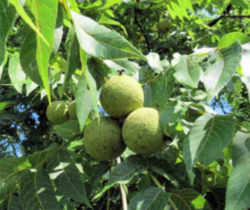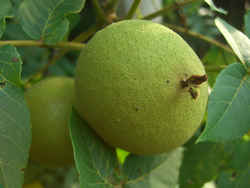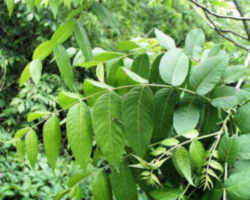
Missouri Symbols
Missouri State Tree Nut
Black Walnut

(Juglans nigra)
Adopted on July 9, 1990.
The nut produced by the black walnut tree, (Juglans nigra,) known as the eastern black walnut, became the state tree nut on July 9, 1990. The nut has a variety of uses. The meat is used in ice cream, baked goods and candies. The shell provides the soft grit abrasive used in metal cleaning and polishing and oil well drilling, and is also used in paint products and as a filler in dynamite. (RSMo 10.100)
Missouri State Tree Nut: Black Walnut

Juglans nigra, the eastern black walnut, a species of flowering tree in the walnut family, Juglandaceae, is native to eastern North America. It grows mostly in riparian zones, from southern Ontario, west to southeast South Dakota, south to Georgia, northern Florida and southwest to central Texas. Isolated wild trees in the upper Ottawa Valley may be an isolated native population or may have derived from planted trees.
Black Walnut, a rapidly growing tree common in the state, is most common in moist bottomlands and open fields, but is found everywhere due to squirrels burying its nuts. Its beautiful, fine-grained, chocolate-brown, relatively lightweight heartwood is the ultimate choice for making solid wood furniture, interior trim, gunstocks, and high-quality veneer. The large nut contained beneath the husks of Black Walnut is round and can be cracked open to expose the bittersweet, oily, and highly nutritious kernel.

A native of the Eastern, Midwestern, and Great Plains regions of the United States, Black Walnut is a pioneer invader tree in open fields or cut-over woodlots, and grows rapidly in youth. It displays an irregular and open growth habit when young, dividing into several spreading branches that give it an upright rounded shape as it matures. Its bold winter texture makes it an outstanding tree to observe during the dormant season. This tree may easily grow to 70 feet tall by 70 feet wide when it is found in the open. As a member of the Walnut Family, it is related to other Walnuts and to the Hickories. The fruit of Black Walnut is composed of an inner kernel, surrounded by a hard corrugated round shell composed of two fused halves. This in turn is surrounded by a thick outer husk that is green when immature (upper right), and yellow-black when ripe. If ripe fruits are picked up, a brown-black dye will easily seep from the moist husk into the skin of your hand, rendering them stained for a couple of days.
Missouri Law
The law designating the black walnut as the official Missouri state tree nut is found in the Missouri Revised Statutes, Title 2, Chapter 10, Section 10.100.
TITLE II SOVEREIGNTY, JURISDICTION AND EMBLEMS
Chapter 10 State Emblems
Section 10.100
State tree nut--black walnut.
10.100. The nut produced by the black walnut tree (Juglans nigra) known as the "Eastern Black Walnut", is selected for and shall be known as the official
tree nut of the state of Missouri.
(L. 1990 S.B. 749)
Taxonomic Hierarchy: Black Walnut
Kingdom: Plantae - PlantsSubkingdom: Tracheobionta - Vascular plants
Superdivision: Spermatophyta - Seed plants
Division; Magnoliophyta - Flowering plants
Class: Magnoliopsida - Dicotyledons
Subclass: Hamamelididae
Order; Juglandales
Family: Juglandaceae - Walnut family
Genus: Juglans L. - walnut
Species: Juglans nigra L. - black walnut

List Official US State Foods






